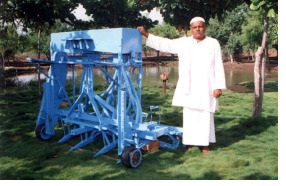Name : Mr. A. I. Nadakattan
District & State : Dharwad, Karnataka
Category : Utility
Award : State
Award Function : 1st National Grassroots Innovation Awards
Award Year : 2001
Innovation Description
 Mr. Nadakattin is a mechanic by hobby, a social worker and an environmentalist as a practitioner. Right from the childhood he was very innovative minded and had a observant nature. He has many small innovations to his credit. His emphasis always has been to promote cost-effective, eco-friendly and socially acceptable methods in agriculture. Even today, at the age of 46, Nadakattin has still not given up his innovative spirit. Some of his popular innovations are: machine to saparate tamarind seeds, tamarind slicer for preparing pickle, harvesting tamarind, bullock drawn tiller etc. Though all his innovations have been appreciated by politicians, researchers and scientists to a large extent but his economic condition has remained more or less the same. He has even sat on a hunger strike accompanied by his wife and two daughters but all in vain.
Mr. Nadakattin is a mechanic by hobby, a social worker and an environmentalist as a practitioner. Right from the childhood he was very innovative minded and had a observant nature. He has many small innovations to his credit. His emphasis always has been to promote cost-effective, eco-friendly and socially acceptable methods in agriculture. Even today, at the age of 46, Nadakattin has still not given up his innovative spirit. Some of his popular innovations are: machine to saparate tamarind seeds, tamarind slicer for preparing pickle, harvesting tamarind, bullock drawn tiller etc. Though all his innovations have been appreciated by politicians, researchers and scientists to a large extent but his economic condition has remained more or less the same. He has even sat on a hunger strike accompanied by his wife and two daughters but all in vain.
(i)Farm ponds measuring 100×100 feet are dug up. Rainwater coming into the bore wells is pumped into the farm ponds and later used for irrigation. (ii) A square pit is created in the centre of four tamarind trees. Along with water, dried leaves and twigs are collected in the pit. In addition, poultry and fish manure mixed with salt and a six-inch layer of sand is kept in the pit. Rainwater is collected in the pit. The pit holds water for a long time due to sand and salt mixture. The water, thus collected, is used for irrigation (iii) Water from the ponds is circulated in the entire farm with a single five-hp motor saving high power consumption.
Lack of adequate water forced the farmer A I Nadakattan to grow tamarind trees after his experiment with mango and sapota failed. He now has 1700 tamarind trees and developed equipment useful for harvesting, separating tamarind and slicing the tamarind for pickles.
For harvesting, he has dug farm ponds, water pits and a technique to save power.
Six farm ponds admeasuring 100x100x10feet were dug. The bore wells, bearing little water earlier, started retrieving more water in two years after the farm ponds were dug. Water from the bore wells was carried to the ponds and later pumped for irrigation after monsoon.
Energy saving irrigation technique:
In the energy-saving technique, single five hp motor pumps water from the two bore wells into a pond with less use of electricity. This water is used for irrigation.
Tamarind Harvester :
Called tamarind harvester, it’s a novel technique. It has hundreds of iron chains hanging from a rod and this carried on a trolley of the tractor. When tamarind is ready for the harvest, the tractor trolley is taken through the rows; the chain is kept loose whereby tamarind falls into the trolley. Due to the chain strokes, the tree is damaged but grows again.
Tamarind Seed Separator :
Called Tamarind seed separator, it was developed in 1994 and is connected to a tractor or an oil engine for enhancing efficiency. In this machine, tamarind is thrown out of the pod due to the sliding action of pegs. The machine works on destining method and saves both time and labour.
Seed Cum Fertilizer Drill :
Called Seed-cum-fertilizer drill, it is used to sow seeds of different sizes. It ensures proper spacing of the seeds, facilitates dispersal of fertilizers, mud and grass. The equipment has a wooden roller for various sizes of seeds. The drill is used in black cotton soil for placing the seeds effectively
Plough blade :
The Plough blade with no whetting need remains sharp for a longer period and does not cause strain on the bullock. The blade can be used for tractors, too. The blade can be sharpened on a low flame without using electricity.
Lifting Cart :
The Lifting cart has the facility of unloading without unfastening the bullock. The traditional cart can be modified with wheel bearings facilitating smooth operation.
Deep Plougher :
Called Deep plougher, it’s a new kind of tiller. It is bullock-drawn and used for tilling.
Water Boiler :
Called the water-boiling heater, it saves fuel. The boiler has an inbuilt mechanism, which consumes only five kg. wood for boiling water for 20 people in five minutes.
http://nif.org.in/innovation/Tamarind_cultivation_under_dry_land_conditions_etc/168
